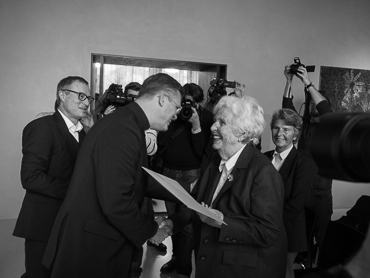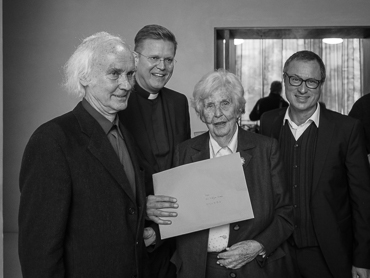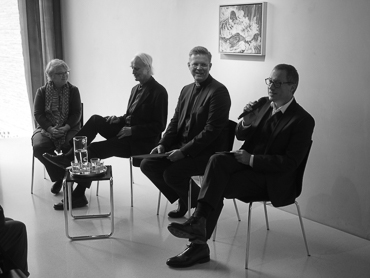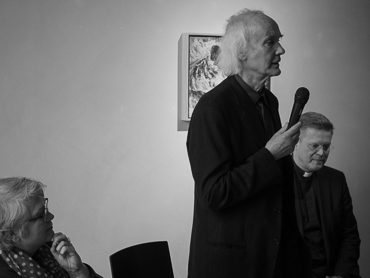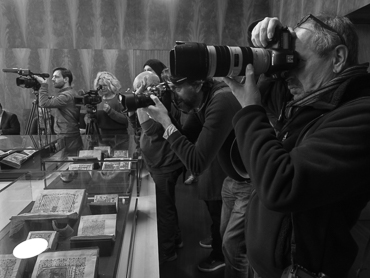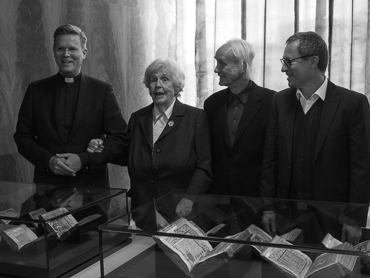12/17 Renate König Donation
7 December 2017
Handing over the Renate König Donation
During a press conference
By accepting one of the most important donations a Cologne museum has ever received, we are coming to the end of our anniversary year in the new Kolumba building. Renate König is gifting to the Art Museum of the Archdiocese her one-of-a kind collection of medieval manuscripts. With academic expertise supplied by Joachim M. Plotzek (Kolumba-Director from 1990 to 2008), over 36 years a collection has come about with great care and the utmost understanding for quality. It consists of 39 magnificently illustrated codices as well as a block book, beginning in the late 13th century and ending in the early 16th century: Among these are books of hours, breviaries and psalteries that are reckoned as being some of the most valuable that miniature painting and book art in the European cultural centers ever produced. With their texts, meant to be read repeatedly each day or for prayers in certain life situations, sometimes tied to indulgences for eternal salvation as well as with picture stories and portrayals of the saints, cheerful drolleries of an “upside-down world” and diverse ornaments, these, for the most part, conveniently-sized codices were their owners’ safe guarantee for managing their daily life. Their use held promises of all kinds of aid for the “art of living a good life and the art of dying well”. Most likely the finest collection in private possession in Germany, it serves as a rich source for the world of images of medieval piety and as a spiritual foundation of private devotion. The collection comprises books made for buyers who have remained anonymous, as well as books that were commissioned by high-ranking persons and thus, individually composed in terms of their texts and adornments. Specimens of book illumination from the finest workshops in Paris and Barcelona, in Naples, Bruges, Utrecht, London and many other places attest to a cultural phenomenon of European dimensions. We are delighted to be able to introduce this donation as a cabinet exhibition in the reading room during the Advent and Christmas Season. “This is a very special day for our Kolumba Museum, for our city, for our Archdiocese. We are receiving a collection of European, of international, standing. In the Holy Scripture, we find experiences of God as told by many persons. In this respect, the books themselves become a precious testament, which is now being handed over to us. The donation by Ms. König reminds us of the power and the might of the book. It is a plea of appreciation for one of the most important cultural achievements in Europe – long before Luther and Guttenberg. But it is also a warning in a country in which books were once burned. This donation is a wonderful Advent offering. It makes us want to read, to be astonished, to pause and gaze at the treasures of the past.” (Dr. Dominik Meiering, Vicar General of the Cologne Archdiocese).
“The richness in content, the artistic diversity in inventing image and decorative motifs as well as the painterly quality, the virtuosity of the calligraphers, whose unerring feeling for the balanced design of the pages of the text are what motivated and served as criteria for Renate König’s decisions to collect these manuscripts over the past forty years. The collection is borne by her enthusiasm for medieval devotional literature and the world of images connected to this.” (Joachim M. Plotzek, Kolumba-Director from 1990 to 2008.
“Without the long years of dedication of numerous supporters, Kolumba’s renown today would not be conceivable. The Renate König-Foundation must be cited here first and foremost. The donation of her private collection of medieval manuscripts has now enabled the Museum to take a quantum leap. With 40 unique books for private devotion, Renate König has laid a foundation in terms of cultural and intellectual history. It bears a collection that allots the book as a medium from the Middle Ages up to the very present day a rank comparable to painting and sculpture. We are eternally grateful for this generous gift on the occasion of our tenth anniversary in the highly praised new building.” (Stefan Kraus).
“Working with the manuscripts is a great joy. The texts and images proffer an abundance of themes in which the self-perception of medieval man is expressed very concretely: the True Devotion to Our Lady, the hope of life after death, the influence of the Sorrows of Christ, the structuring of time with Church Feasts and the longing to never be forgotten – to cite only those thematic
complexes we address in this exhibition. In the case of other opened pages, an entirely different narration might arise.” (Ulrike Surmann)
Handing over the Renate König Donation
During a press conference
By accepting one of the most important donations a Cologne museum has ever received, we are coming to the end of our anniversary year in the new Kolumba building. Renate König is gifting to the Art Museum of the Archdiocese her one-of-a kind collection of medieval manuscripts. With academic expertise supplied by Joachim M. Plotzek (Kolumba-Director from 1990 to 2008), over 36 years a collection has come about with great care and the utmost understanding for quality. It consists of 39 magnificently illustrated codices as well as a block book, beginning in the late 13th century and ending in the early 16th century: Among these are books of hours, breviaries and psalteries that are reckoned as being some of the most valuable that miniature painting and book art in the European cultural centers ever produced. With their texts, meant to be read repeatedly each day or for prayers in certain life situations, sometimes tied to indulgences for eternal salvation as well as with picture stories and portrayals of the saints, cheerful drolleries of an “upside-down world” and diverse ornaments, these, for the most part, conveniently-sized codices were their owners’ safe guarantee for managing their daily life. Their use held promises of all kinds of aid for the “art of living a good life and the art of dying well”. Most likely the finest collection in private possession in Germany, it serves as a rich source for the world of images of medieval piety and as a spiritual foundation of private devotion. The collection comprises books made for buyers who have remained anonymous, as well as books that were commissioned by high-ranking persons and thus, individually composed in terms of their texts and adornments. Specimens of book illumination from the finest workshops in Paris and Barcelona, in Naples, Bruges, Utrecht, London and many other places attest to a cultural phenomenon of European dimensions. We are delighted to be able to introduce this donation as a cabinet exhibition in the reading room during the Advent and Christmas Season. “This is a very special day for our Kolumba Museum, for our city, for our Archdiocese. We are receiving a collection of European, of international, standing. In the Holy Scripture, we find experiences of God as told by many persons. In this respect, the books themselves become a precious testament, which is now being handed over to us. The donation by Ms. König reminds us of the power and the might of the book. It is a plea of appreciation for one of the most important cultural achievements in Europe – long before Luther and Guttenberg. But it is also a warning in a country in which books were once burned. This donation is a wonderful Advent offering. It makes us want to read, to be astonished, to pause and gaze at the treasures of the past.” (Dr. Dominik Meiering, Vicar General of the Cologne Archdiocese).
“The richness in content, the artistic diversity in inventing image and decorative motifs as well as the painterly quality, the virtuosity of the calligraphers, whose unerring feeling for the balanced design of the pages of the text are what motivated and served as criteria for Renate König’s decisions to collect these manuscripts over the past forty years. The collection is borne by her enthusiasm for medieval devotional literature and the world of images connected to this.” (Joachim M. Plotzek, Kolumba-Director from 1990 to 2008.
“Without the long years of dedication of numerous supporters, Kolumba’s renown today would not be conceivable. The Renate König-Foundation must be cited here first and foremost. The donation of her private collection of medieval manuscripts has now enabled the Museum to take a quantum leap. With 40 unique books for private devotion, Renate König has laid a foundation in terms of cultural and intellectual history. It bears a collection that allots the book as a medium from the Middle Ages up to the very present day a rank comparable to painting and sculpture. We are eternally grateful for this generous gift on the occasion of our tenth anniversary in the highly praised new building.” (Stefan Kraus).
“Working with the manuscripts is a great joy. The texts and images proffer an abundance of themes in which the self-perception of medieval man is expressed very concretely: the True Devotion to Our Lady, the hope of life after death, the influence of the Sorrows of Christ, the structuring of time with Church Feasts and the longing to never be forgotten – to cite only those thematic
complexes we address in this exhibition. In the case of other opened pages, an entirely different narration might arise.” (Ulrike Surmann)
